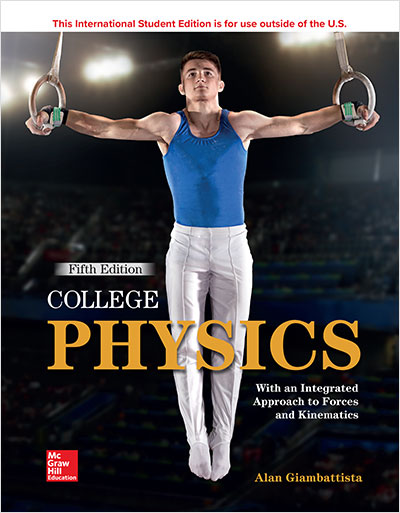대학교재
College Physics, 5th Edition
International Student Edition | (Paperback)
한빛아카데미
원서
판매중

- 저자 : Alan Giambattista
- 출간일 : 2020-01-01
- 페이지 : 1232쪽
- ISBN : 9781260547719
- 물류코드 :89990
-
College Physics is intended for a two-semester college course in introductory physics using algebra and trigonometry. The main goals for this book are:
- to present the basic concepts of physics that students need to know for later courses and future careers,
- to emphasize that physics is a tool for understanding the real world, and
- to teach transferable problem-solving skills that students can use throughout their lives.
A CONCEPTS-FIRST APPROACH
CollegePhysics emphasizes that a relatively smallnumber of basic physics concepts are applied to a wide variety of situations.The presentation in College Physics blends conceptual understanding withanalytical skills. The “concepts-first” approach helps students developintuition about how physics works; the “formulas” and problem-solving techniquesserve as tools for applying the concepts. The Conceptual Examples and Conceptual PracticeProblems in the text and a variety of ranking tasks and Conceptual and Multiple-Choice Questionsat the end of each chapter give students a chance to check and to enhancetheir conceptual understanding.
AN INTEGRATED APPROACH TO FORCES AND KINEMATICS
As part of the concepts-first approach, the organization of this text differs in a few places from that of most textbooks. The most prominent of these the treatment of forces and motion. In College Physics, the central theme of Chapters 2–4 is Newton’s laws of motion. Chapter 2 sets the conceptual framework by introducing forces and Newton’s laws. Kinematics is then introduced in Chapters 3 and 4 as a tool to understand how forces affect motion.
INTRODUCING CONCEPTS INTUITIVELY
Key concepts and quantities are introduced in an informal and intuitive way, using a concrete example to establish why the concept or quantity is useful. Concepts motivated in this way are easier for students to grasp and remember than are concepts introduced by seemingly arbitrary, formal definitions.
DESIGNED FOR ACTIVE LEARNING
Previous editions of College Physics have been tested for over 15 years in Cornell’s nontraditional course, where students rely on the textbook as their primary source of information because there are no lectures. The text is therefore well suited to use in flipped classrooms and other nontraditional course formats. Nonetheless, completeness and clarity are equally advantageous when the book is used in a more traditional classroom setting. College Physics frees the instructor from having to try to “cover” everything. The instructor can then tailor class time to more important student needs—reinforcing difficult concepts, working through Example problems, engaging the students in peer instruction and cooperative learning activities, describing applications, or presenting demonstrations.
WRITTEN IN A CLEAR AND FRIENDLY STYLE
College Physics was developed specifically for the algebra/trig-based course; it’s not a spinoff of a calculus-based text for engineers or physics majors. The writing is intended to be down-to-earth and conversational in tone—the kind of language an experienced teacher uses when sitting at a table working one-on-one with a student. Students should feel confident that they can learn by studying the textbook.
MCAT® SUPPORT
Coverage of topics such as mechanical advantage, turbulence, surface tension, attenuation of sound waves, magnetic materials, and circular polarization has been expanded or added to this edition based on the 2015 revision of the MCAT® exam. Students who plan to take the MCAT® can rest assured that all the physics topics on that exam are included in the text.